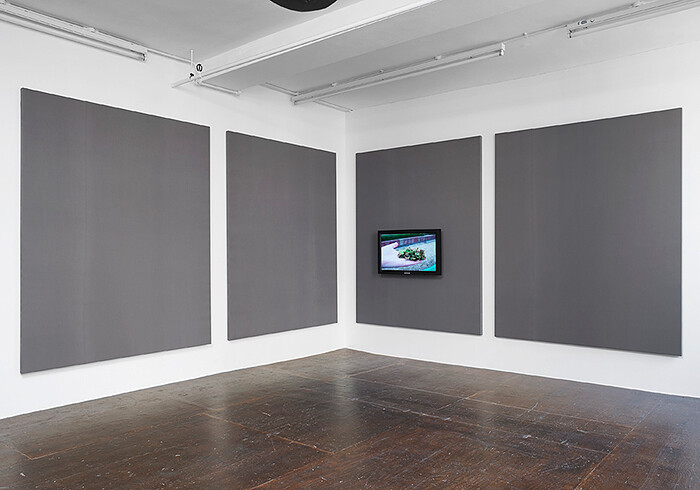Andrea Büttner’s second show at Hollybush Gardens is a study in humility, painted in a shade of don’t-look-at-me grey. The dominant color in the exhibition is that particular commonplace grey of worker’s uniforms—the cheap, mass-produced pencil skirts of hotel workers and public servants, or school uniform blazers. It’s the fabric used to make such clothing that Büttner has stretched over canvas to create several large “fabric paintings.” One immediately thinks of Gerhard Richter’s Grey painting series (1967–1986), yet the varyingly placed stitched seams running vertically down each of Büttner’s panels nod quietly to the “zips” of Barnett Newman’s paintings. Nowhere does this dull fabric look more like a uniform than down this line, which immediately brings to mind the long seam on a pair of trousers. Unlike Newman’s zips, however, these fabric paintings could, theoretically, be physically ripped apart—split down those long seams, as though one might be able to liberate a gloriously fleshy expanse of hips or thighs beneath. But, for now, everything is covered over, modestly.
Though the seams create an unlikely point of tension, such interpretational inflections are accentuated if one is made aware of Büttner’s interest in humility and shame. For her previous exhibition here she painted the walls in a very rich brown paint as high as she could reach, bringing together associations with faeces, and in particular the idea of a dirty protest (referring to the room as a “shit space”), though it also conveyed a chocolaty warmth and a woody, traditional atmosphere. Here such themes are played out in a different key, and the artist veers towards the harder end of asceticism. It’s not an easy show, and it contains a subtle shadow of that willfulness that prompted the artist to take up defiantly “anti-cool” processes such as glass painting and woodcut printing (she once graffitied the words “I was uncool before you were uncool” on the window of Bless, a trendy fashion shop in Berlin). And, though she has since disavowed any interest in taking such a position, a certain obstinacy remains, as well as a certain deviance.
On one panel, Büttner has mounted a flatscreen monitor, displaying photographs of moss that the artist has collected. Mostly unassuming, mosses make a soft raid over concrete paving and walls, and on bare soil. Green fronds and fuzz show up the hidden fecundity of in such spaces—analogous to a form of modest sexuality—on stone statues and brick and, by extension, on the bodies under those grey uniforms. Büttner emphasizes the delicacy of these small, determined leaflets; their “littleness” is also a reminder of the artist’s well-known film Little Works (2007), in which she gave video cameras to a convent of Carmelite nuns to document the offerings that they created for a festival, as well as the anxieties and excitements of the nuns in the build up to showing what they had made. As utterly charming and surprising as this film was, it also revealed a tension inherent in opening up the sanctuary of the convent, and the peculiar worry that the sisters felt that they had to “open up” somehow to the world without physically letting someone in to the sanctified space: a seam of sorts.
Büttner has also employed the “corner space” as a motif within this exhibition. This is first seen in Grey Corner (2011), a woodblock print made from three different shades of grey to represent the intersection of two walls and a floor, giving a view into another expression of shame, perhaps (“go stand in the corner”). The other corner is a makeshift bench structure made from plastic tubs and pieces of wood. This corner, in contrast, seems open, because to sit on the bench means to face into the room. The exhibition’s unobtrusive sound piece, Live Oak Friends Meeting, Houston (2011), is a quiet recording of a group of Quakers mutely praying in a meeting house which happens to feature a James Turrell skyspace. The skyspace is another example of a gap in the world, a seam in the silence of prayer, through which the world unassumingly, but determinedly, creeps in, and this “silent” work, like any performance of John Cage’s 4’33 (1952), is full of everyday sounds: birds singing, planes passing overhead, and bodies occasionally shifting. Silence, it turns out, we can’t really hear. But in the case of prayer, we still strain to hear or feel it in the recording, as though a spirit or energy might remain on record, underneath the fuzz—almost an aural moss—of the everyday.




